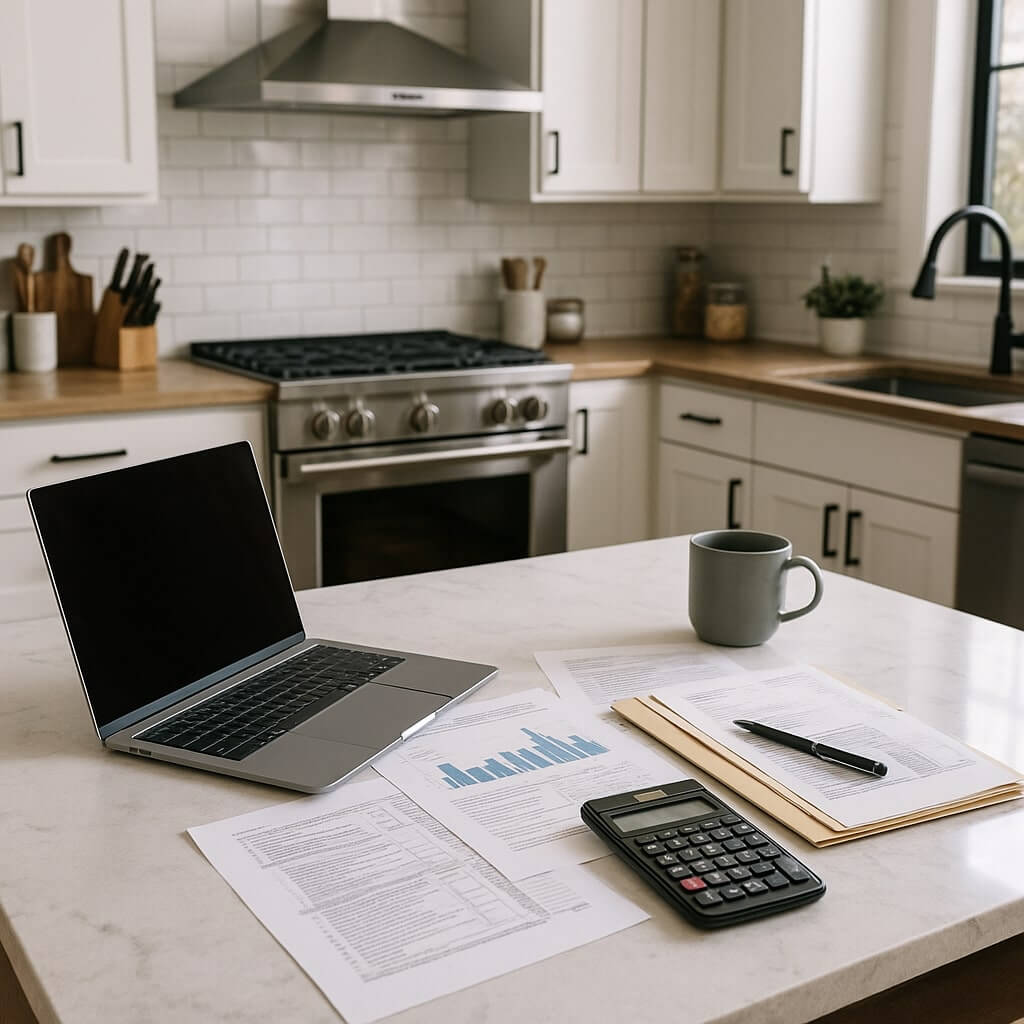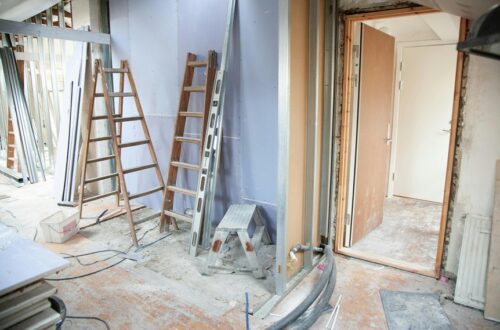When considering a kitchen remodel, understanding how to maximize tax deductions can greatly impact your budget. By focusing on qualifying projects and energy-efficient upgrades, you can leverage tax credits to offset costs. However, it is important to meticulously document your expenses and navigate the complexities of tax laws. Exploring these strategies can lead to substantial savings, but knowing where to start is vital for achieving the best outcome.
Key Takeaways
- Focus on energy-efficient upgrades, like Energy Star appliances, which can lead to significant tax credits and deductions.
- Prioritize structural improvements over cosmetic changes, as only the former typically qualify for tax deductions.
- Keep meticulous records of all expenses, including receipts and photos, to substantiate deductible costs during tax filing.
- Consult a tax professional to ensure compliance and identify eligible deductions specific to your kitchen remodel.
- Research available state or municipal grants and rebates for energy-efficient renovations to further reduce remodeling expenses.
Understanding Tax Deductions for Home Improvements
While you might think all home improvements are eligible for tax deductions, understanding the specifics is vital. Not every renovation qualifies for tax benefits; generally, only improvements that increase your home’s value or extend its life count.
For instance, utilizing your home equity to finance upgrades can potentially offer deductions on interest payments. However, it’s important to differentiate between repairs and improvements, as only the latter may provide tax advantages.
Familiarizing yourself with IRS guidelines will help you identify which projects align with eligibility criteria, ensuring you maximize your tax benefits when it comes to home improvements.
Qualifying Kitchen Remodeling Projects

When planning your kitchen remodel, it’s crucial to identify which projects qualify for tax deductions.
Upgrading to energy-efficient appliances, making structural improvements, and considering accessibility enhancements can all enhance your home’s value while potentially reducing your tax burden.
Understanding these qualifying projects will help you maximize your deductions effectively.
Energy-Efficient Appliances Upgrade
How can upgrading to energy-efficient appliances enhance both your kitchen and your tax savings?
Investing in modern, energy-efficient appliances not only improves your kitchen’s functionality but also provides substantial benefits through energy savings and appliance rebates.
Consider these points:
- Reduced Utility Bills: Energy-efficient appliances consume less power, leading to lower monthly energy costs.
- Tax Credits: Many energy-efficient upgrades qualify for federal or state tax credits.
- Rebates: Local utilities often offer appliance rebates for upgrading.
- Increased Home Value: Potential buyers appreciate energy-efficient features, enhancing your home’s market appeal.
These factors make upgrading an intelligent financial decision.
Structural Improvements Eligibility
Understanding which structural improvements qualify for tax deductions in your kitchen remodel can greatly impact your overall savings.
When you focus on enhancing the structural integrity of your kitchen, like adding load-bearing walls or reinforcing flooring, these renovations may be eligible for deductions. Confirm you’re tracking all renovation costs associated with these improvements.
However, cosmetic upgrades, such as painting or new cabinetry, typically don’t qualify.
By prioritizing structural changes that enhance functionality and safety, you can strategically position your remodeling project for potential tax benefits, ultimately maximizing your financial return.
Keep detailed records to support your claims when filing.
Accessibility Enhancements Consideration
As you evaluate your kitchen remodeling plans, incorporating accessibility enhancements can’t only improve usability for all family members but may also qualify for tax deductions.
Focusing on universal design features can help you create a space that accommodates aging in place. Here are four enhancements to evaluate:
- Install adjustable cabinets and countertops for varied heights.
- Use non-slip flooring to prevent falls.
- Incorporate pull-out shelves for easier access.
- Add lever-style handles on doors and faucets.
These enhancements not only promote safety and comfort but also align with tax deduction criteria, making your investment even more valuable.
Energy Efficiency Upgrades and Tax Credits
When you’re considering kitchen remodeling, incorporating energy-efficient products can greatly enhance your tax savings.
Various federal tax credits exist for qualifying upgrades, which can help offset the costs of your new appliances and fixtures.
Understanding these incentives allows you to make informed decisions that benefit both your home and your wallet.
Qualifying Energy Efficient Products
Energy efficiency upgrades in your kitchen not only enhance comfort and functionality but can also lead to significant tax credits.
To qualify for these benefits, focus on products meeting specific criteria:
- Energy Star Appliances: Verify your new refrigerator or dishwasher is Energy Star certified.
- Efficient Lighting: Replace old fixtures with LED lights that meet energy standards.
- Smart Thermostats: Install devices that optimize energy usage and qualify for appliance rebates.
- Tax Forms: Keep documentation for eligible purchases to accurately report on your tax forms.
Check eligibility criteria to maximize your deductions effectively.
Available Federal Tax Credits
Numerous federal tax credits are available for homeowners who invest in energy efficiency upgrades during their kitchen remodeling projects.
By utilizing these federal incentives, you can potentially reduce your overall tax liability. To qualify, it’s crucial to ascertain your upgrades meet specific criteria outlined by the IRS, which determines tax eligibility.
Common eligible upgrades include energy-efficient appliances, windows, and insulation. Keep detailed records of your purchases and installations, as you’ll need to provide this documentation when claiming credits.
Staying informed about current regulations can help you maximize these benefits, making your kitchen remodel both eco-friendly and financially advantageous.
Documenting Your Expenses
To maximize your tax deductions on a kitchen remodeling project, meticulously documenting your expenses is vital.
Effective expense tracking and receipt organization will guarantee you capture every deductible cost. Here are four key items to keep in mind:
- Receipts: Always save receipts for materials and labor costs.
- Invoices: Organize invoices from contractors and suppliers.
- Photos: Take before-and-after photos to visually document changes.
- Spreadsheets: Maintain a spreadsheet to log all expenses, categorizing them for clarity.
Hiring Professional Help and Tax Implications
When you hire professional help for your kitchen remodeling, understanding the tax implications can greatly impact your overall expenses.
Many homeowners overlook that hiring licensed contractors or designers may qualify you for certain deductions. For instance, if your remodel enhances the value of your home, you could potentially deduct these costs when selling.
Hiring licensed contractors may qualify you for deductions, especially if your remodel increases your home’s value.
Additionally, expenses related to professional help, like fees for consultations or design services, might be deductible if the remodel meets specific criteria.
Always keep detailed records and consult a tax professional to navigate these complexities effectively and maximize your potential savings.
Home Office Deductions in Kitchen Remodels

If your kitchen remodel includes a designated home office space, you may be eligible for valuable tax deductions.
To maximize these benefits, consider the following:
- Proportionate Expenses: Deduct a portion of kitchen renovation costs relative to your home office size.
- Furniture and Equipment: Claim deductions for office furniture and technology integrated into your kitchen design.
- Utilities: Include a share of your utility bills, reflecting the office’s usage.
- Renovation Materials: Document expenses for materials specifically used to enhance the home office area.
Navigating Local and State Tax Incentives
While maneuvering through the complex landscape of local and state tax incentives, homeowners should be aware that various programs might greatly offset your kitchen remodeling costs.
Begin by researching local incentives that may apply to energy-efficient appliances or sustainable materials. Many municipalities offer grants or rebates aimed at promoting environmentally friendly renovations.
Additionally, don’t overlook state rebates that can further reduce your expenses. These financial incentives can vary considerably, so check eligibility requirements and application processes.
Consulting a Tax Professional for Optimal Benefits
Engaging a tax professional can greatly enhance your ability to maximize benefits from kitchen remodeling deductions.
Their expertise is invaluable for effective financial planning. Here’s how they can help:
- Identify eligible deductions specific to your remodel.
- Guarantee compliance with local and federal tax laws.
- Offer strategic advice on timing your expenses.
- Assist in documenting costs accurately for future audits.
Conclusion
To sum up, maximizing tax deductions for your kitchen remodeling project requires careful planning and attention to detail. By focusing on energy-efficient upgrades, documenting all expenses, and understanding the nuances of tax laws, you can greatly enhance your potential savings. Don’t hesitate to seek professional guidance to navigate eligibility and compliance effectively. With the right approach, you can transform your kitchen while reaping the financial benefits that come from smart remodeling choices.






